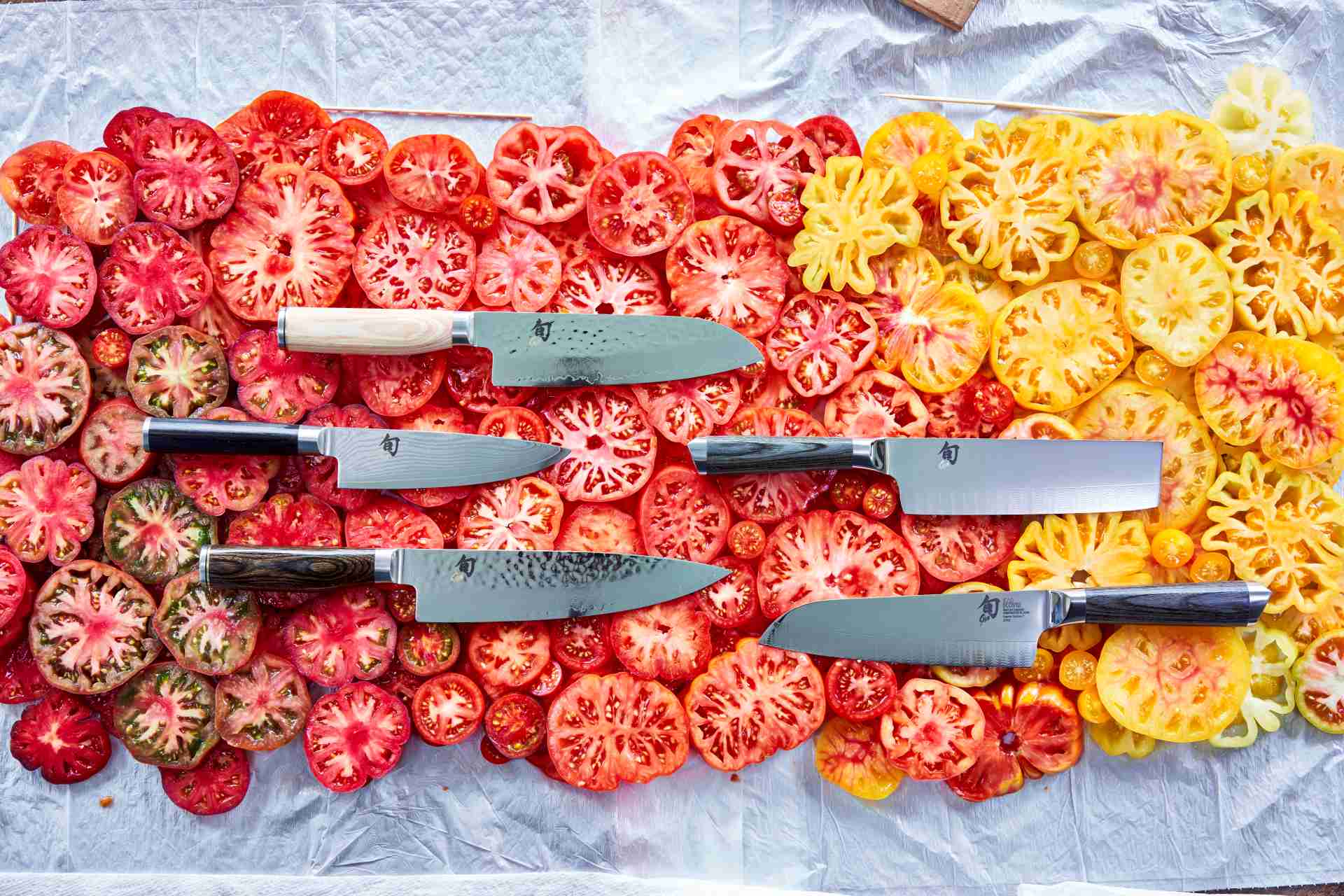Become the Hostess With The Mostest


Japanese kitchen knives embody a blend of art and function, captivating chefs and food enthusiasts with their unmatched precision and enduring craftsmanship. Born from age-old techniques initially used in samurai sword making, these knives offer more than just utility—they represent a heritage of meticulous craftsmanship appreciated worldwide.
In this guide, discover the most popular types of Japanese kitchen knives, learn how they’re made and get tips on choosing the perfect blade that best suits your culinary adventures.
Hungry for more? Our new Shun Kagerou collection is the perfect way to elevate your kitchen, with top-of-the-line blades made in the Japanese tradition.
Japanese culinary knives are distinguished by their specific designs and intended uses, each shaped to perform optimally for particular tasks. Here are some of the most common types that you might consider adding to your culinary toolkit:
The Gyuto is the Japanese equivalent of the Western chef’s knife. It features a thinner and lighter blade that makes it versatile for a variety of tasks, including chopping, slicing and mincing both meat and vegetables.
Typically ranging from 7–12 inches, the Gyuto offers a balance between sharpness and strength, making it a fundamental tool in any kitchen.
The Santoku, or “three virtues,” is adept at slicing, dicing and mincing, making it perfect for cutting everything from meat to vegetables.
It’s designed with a shorter and broader blade than the Gyuto, enhancing its versatility for various kitchen tasks. The blade has a flat edge and ends with a rounded tip, which is great for a straightforward chopping motion rather than the rocking technique used with longer blades. With its compact and lightweight design, the Santoku is a go-to for chefs who need a knife that’s easy to handle and works well for precise cuts.
The Nakiri boasts a straight blade perfect for cutting all the way down to the chopping board without the need for pulling or pushing. This makes it ideal for slicing and dicing vegetables.
The double-beveled edge also allows for thin, consistent cuts without damaging delicate ingredients. The Nakiri typically has a blade length of about 5–7 inches, which provides ample cutting surface while maintaining control and ease of use.
The utility knife is a smaller Japanese knife, similar to the Western paring knife, with a typical blade length ranging from 4.5–7 inches. It is highly versatile, perfect for tasks that require precision, such as peeling fruits, deveining shrimp or carving small garnishes.
The smaller size of the utility knife allows for exceptional maneuverability and control, making it ideal for detailed and delicate cutting tasks.
The Sujihiki knife, known for its ability to precisely slice boneless meats and fillet fish, is a specialized Japanese kitchen knife. Its name, translating to “muscle cutter” or “flesh slicer,” highlights its function in creating clean, smooth cuts with minimal tearing.
With a long, narrow and slender blade, typically ranging from 8–14 inches, the Sujihiki allows for long, uninterrupted strokes essential for maintaining the integrity of meat or fish.
This knife is akin to the Western carving knife but features a lighter and thinner design for enhanced control and reduced fatigue, making it ideal for both sashimi preparation and carving cooked meats, especially when presentation is key.
The Gokujo is a heavy-duty knife primarily used for filleting fish and cutting through fish bones. Its thick and heavy blade—typically 6–8 inches or longer—provides the necessary heft to handle tougher tasks, while the single-beveled edge ensures precise cuts.
While mainly for fish, the gokujo can also be used for poultry and other meats.
Renowned for their exceptional craftsmanship, Japanese culinary knives are made using a tradition that dates back centuries and is rooted in the same techniques once used to forge samurai swords. Their creation involves a meticulous process that combines traditional methods with modern technology to produce blades of unparalleled quality and performance.
The journey of a Japanese knife starts with forging, where the chosen metal is heated to high temperatures and then hammered into shape. This process is crucial for aligning the grain structure of the steel, enhancing the knife’s strength and durability.
Skilled shokunin, master craftsmen dedicated to their trade, repeatedly fold and hammer the metal to eliminate impurities and create a blade that can hold a sharp edge.
After forging, the blade undergoes heat treatment and tempering. This involves heating the blade to a specific temperature and then cooling it rapidly, a process that hardens the steel.
Tempering follows, where the blade is reheated to a lower temperature and allowed to cool slowly, reducing brittleness and enhancing toughness. This delicate balance between hardness and flexibility is essential for creating a blade that is both sharp and resilient.
Once the blade is forged and treated, it is sharpened and finished. Expert sharpeners use a series of whetstones with progressively finer grits to hone the blade to a razor-sharp edge.
The final polishing and finishing touches involve careful inspection and adjustment to ensure that the knife performs flawlessly. This step often includes creating a mirror-like finish that not only enhances the blade’s appearance but also reduces friction during cutting.
Japanese knives are made from a variety of high-quality materials, each offering unique benefits:
Choosing the right Japanese knife can greatly enhance your culinary experience. Here are some tips to help you make the best decision:
First, assess your cooking habits and tasks. Think about what you cook most frequently.
Are you more focused on slicing vegetables, filleting fish or chopping meat? This will guide you in selecting the right type of knife. Additionally, consider the types of ingredients you commonly use.
If you frequently prepare vegetables, a Nakiri might be best. For general use, a Gyuto or Santoku could be more suitable.
The blade material is crucial for performance and maintenance, and each variety has its pros and cons.
High-carbon steel offers superior sharpness and edge retention, but it requires regular maintenance to prevent rust and corrosion.
Stainless steel is easier to maintain and more resistant to corrosion, making it a good choice for home cooks who prefer low-maintenance knives, but it may not hold an edge as long as high-carbon steel.
Damascus steel is known for its beautiful patterns and excellent performance, combining layers of different steels for a balance of hardness and flexibility, but it can be more expensive and may still require careful maintenance.
Ergonomic design is essential for prolonged use, reducing fatigue and enhancing control.
Handles can be made from wood, composite materials or metal. Wooden handles are traditional and lightweight, while composite and metal handles are durable and often heavier.
Match the handle design to the blade for a balanced feel, ensuring the handle provides a secure and comfortable grip.
Choosing the appropriate blade length for specific tasks is important.
Shorter blades (5–7 inches) are ideal for precision tasks like peeling and making small cuts, while longer blades (8–12 inches) are better for slicing large cuts of meat or fish.
The shape of the blade also affects its functionality. For example, a straight edge (Nakiri) is great for chopping vegetables, while a curved edge (Gyuto) allows for a rocking motion ideal for general tasks.
Proper cleaning and storage are crucial for the longevity of your knife.
Always hand wash your knives and dry them immediately to prevent rust and corrosion. Store them in a knife block, magnetic strip or blade guard to protect the edges. Regular sharpening is essential to maintain the knife’s performance.
Use a whetstone for sharpening, and hone the knife regularly to keep the edge aligned. The frequency of sharpening depends on usage, but generally, a high-carbon steel knife needs more frequent sharpening compared to stainless steel.
Hungry for more? Our new Shun Kagerou collection is the perfect way to elevate your kitchen, with top-of-the-line blades made in the Japanese tradition.
Join The Conversation